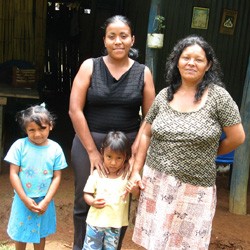
Panama is facing a major challenge in the Panama Canal Watershed. Next to the backdrop of gigantic, modern cargo ships transiting the Canal, lies an area of extreme poverty, where much of the population scrapes a meager living off small farms. The contrast between the modern, prosperous Panama and the underprivileged, poor one underscores the country’s dual economy.
Like many people in the Canal Watershed, Yadira Martinez and her family live in a shack with earthen floors and a thatched roof. They are often unable to meet basic needs, such as adequate nutrition. USAID’s sustainable agriculture programs are reaching out to people like Yadira to teach them more effective agricultural techniques. The first thing she mentioned about the program’s impact was that better crop yields are helping her daughters, who were underweight, overcome undernourishment. “My daughters showed significant weight gain at their last visit to the doctor,” said the 21-year old mother, with visible relief. Her mother, Beatriz Rodriguez, said, “We did not have money to buy tomatoes, green beans, corn, and the like. So we survived without them. Now, Yadira plants and harvests these crops.” Yadira also sells part of her harvests to neighbors who value organically grown crops.
“I opened a savings account with the proceeds from the sales,” Yadira said proudly. So far, her savings total $11 dollars — a lot for her. Encouraged by her daughter’s success, Beatriz has cleared land to replicate the techniques Yadira used.
USAID sponsored training for 30 farmers in the Los Hules Tinajones area in sustainable agriculture. These farmers are replicating best practices and generating more income while containing soil erosion and conserving water critical to both the area’s ecology and the Canal’s operation.







Comment
Make a general inquiry or suggest an improvement.